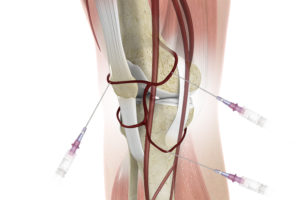Who would benefit from this procedure?
Individuals with knee pain that is secondary to arthritis or have failed aggressive knee replacement surgery and continue to have persistent knee pain.
How does this work?
The combination of a local anesthetic at times mixed with steroid is injected to anesthetize three branches of the Genicular nerves which surround the knee joint along the femur and tibia which results in pain control.
How is the procedure done?
The patient will either lie on his/her back and knee is placed in a flexed position. The skin is first cleaned in proper surgical sterile fashion, a needle is directed to the distal femur and proximal tibia location of the genicular nerves under x-ray guidance. Than a medication mixture (local anesthetic with or without steroid) is then injected.
What are the potential risks?
Although this is a very safe procedure, it is not without risk. Whenever a needle is used there is always the risk of infection and bleeding.
What should I expect after the procedure?
It is normal to experience temporary soreness at the need placement sites. If effective pain relief is experienced within the first 30 minutes of the procedure. The pain relief typically last several hours when local anesthetic is used alone or several days if steroids are added.
The Genicular nerve block is a diagnostic test; thus the benefit is supposed to wear off within a short time span 6 hours to several days.
If the Genicular nerve block is effective in providing temporary pain relief, than it is repeated a second time to confirm that the genicular nerves are truly the source of your pain.
After completing both visits for your genicular nerve blocks with success of pain relief than this is followed by a procedure titled “radiofrequency ablation or Rhizotomy” of these nerves. The radiofrequency ablation than provides improved pain control that can last 6 months or longer.

